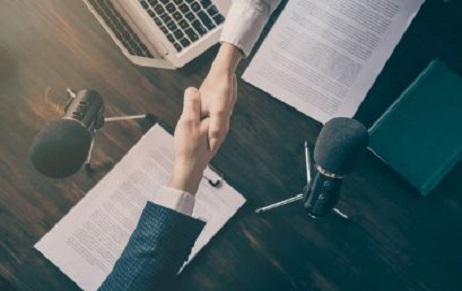Intellectual Property Rights (IPR) are like different keys for different locks. Just like every lock…
Comprehending Broadcasting Contracts and Intellectual Property Law at Crossroads
Introduction
Amidst the ongoing controversies and criticisms regarding the draft of Broadcasting Services (Regulation) Bill 2023 & 2024 (Draft Bills) and the government’s continuous regularization attempts of the broadcasting industry, it is pertinent, that we look at the potential impacts of the previous drafts and existing law impacting the often overlooked intellectual property rights of people involved in the broadcasting domain. The continuous technological advancements cause unexpected ways of copyright distribution and the broadcasting sector is not indifferent to it. From DVDs to OTT, the entertainment domain has come a long way owing to rapid digitalization affecting creative authorship over their creations[1]. Recent court decisions have clarified the scope of copyright in film screenplays, personality rights, and underlying works concerning content creation and licensing in broadcasting.
The current broadcasting sector in India is regulated by a patchwork of laws and guidelines which the government is still seeking to modernize and consolidate apparent from the latest bills getting retracted to address all sorts of evolutions and improvements. Hence, commercialization occurs by distributing contracts among the authors and directors/publishers to distribute their works. Poorly drafted broadcasting agreements therefore attract numerous conflicts over profit distribution. The recent disputes involving content distributing platforms like Netflix, and producers like Star India, Zee, Super Cassettes Industries Pvt. Ltd also known as T-series, regarding their show[2] or film’s revenues are a demonstration of contesting instances relating to intellectual property rights in the sector[3].
What is a Broadcasting agreement?
Like any contract, a broadcasting agreement is entered between the concerned parties ascertaining their rights and obligations with respect to their content as a document enforceable in the eyes of law. Mainly these agreements involve the content’s producer, the broadcaster, and other parties involved in negotiating and providing license to the broadcaster with exclusive rights to broadcast, transmit, rebroadcast, remake, and notify the public for a particular time frame and for a consideration agreed by the parties. The origin of these broadcasting rights also known as media rights can be traced back to the 1962 Rome Convention that specified the exercise of such rights for 20 years, but the current Indian scenario exceeds this international standard and grants a 25-year protection according to section 37 of the Indian copyright Act 1957 owing to broadcasting being a public service[4]. It is interesting to note that the draft bills also include “OTT & Terrestrial Broadcasting Networks” within the definition of “Broadcaster” expanding the scope of regulation due to high content consumption in the two arenas.
Current Broadcasting regulation in India.
While the current bills are still under scrutiny and awaiting suggestions from the stakeholders for further amendments, the bills are supposed to introduce some mandates governing the licenses and economic capacities of the parties to such agreements. Currently, the only way legal enforcement can be done for broadcasting agreements is the common law including contract law, intellectual property law, arbitration, and competition law. It is noteworthy that the upcoming bills broaden their shoulders to bring a large section of social media content creators and seek to bring them within the purview of their guidelines, which carries the possibility of bringing down various kinds of broadcasters, including the ones on digital platforms. Bodies like the Telecom Regulatory Authority of India (TRAI) look over all broadcasting content except OTT which is currently being supervised by the Information Technology Act, 2000 but the overall regulatory aspect of these novel mediums remains uncertain until the draft bills are passed.
Intellectual Property Law and Broadcasting contracts
Media channels and various broadcasting platforms have found numerous ways to monetize information dissemination through comedies, serials, news, etc., and undoubtedly creating such content includes the distribution of any intellectual property rights to their respective authors. For example, a cinematograph film is created by the combined effort of the producers, directors, actors, composer, etc which eventually creates underlying rights within its musical works, literary works in screenplays, artistic works, and many more. But when such movies let’s say are remade after decades, what happens to the original intellectual property rights holders now that the broadcasters have changed? These situations are governed by the initial contracts entered between the broadcasting organizations and negotiate the royalties, time, absolute or partial transfer of rights, and licensing. Any such distribution of work not based upon any legal contract with the distributors or the producer amounts to infringement as held by the Delhi High Court in ESPN Software Private India Ltd. vs Tudu Enterprise and Ors prohibiting the defendants from distributing the plaintiff’s programs through their unauthorized cable operators without any license agreements attracting section 37(3) of the Indian Copyright Act 1957[5].

While the characters are livened by the way an actor portrays them, the media industry has been introduced to personality rights that specifically is owned by the actors. Courts have granted relief to several celebrities including Jackie Shroff, Rahul Dravid, and Anil Kapoor to Amitabh Bachchan ensuring the protection of an individual’s reputation associated with their characters. Another aspect of such broadcasting contracts in the form of Statutory Licensing agreements poses a conflicting scenario for the upcoming digital media, given the Bombay High Court judgment in Tips Industries Ltd vs Wynk Ltd. And Anr.[8] held that section 31 D of the Copyright Act does not include internet broadcasting within its scope, while the draft bills clearly are trying to bring OTT and social media within its ambit.
Pertinent legal challenges in Broadcasting Contracts in India
- Standard Essential Patents in Broadcasting Technology: The broadcasting sector also runs through various technologies from equipment manufacturers to service providers, looking for such technology licensing agreements. The structures of such broadcasting contracts are also to be protected to run free of undue influences, coercion, or fraudulent practices through the terms of such contracts. The Draft Patents (Amendment Rules) 2023 can be accommodating of such technology-related patents in broadcasting.
- Regulation of Digital News Broadcast: While the proposed draft bills seek to regulate Digital news Broadcasters, including social media accounts that share news content, this raises new challenges for broadcasting agreements between the content creators and platforms in terms of intellectual property management.
- Interpretation and enforcement: Disputes between the right holders mostly arise out of the unilateral interpretation of terms of such contracts entered into. Thus drafting of such clauses must be ambiguity-free and devoid of territorial restrictions including clarity in rights over new mediums of distribution attributed to upcoming technologies[9].
- Global applicability: As already mentioned, broadcasting contracts must be amenable to the transborder application of intellectual property rights so that both national and international broadcasters can reach the Indian market with certainty. In such cases, the Berne Convention’s and TRIPS (Trade-Related Aspects of Intellectual Property Rights) Agreement’s exclusive rights granting automatic protection must always be conformed with.
Conclusion
As the Draft Bills, legislative amendments, and court decisions are reshaping the landscape of protection of intellectual property rights in the broadcasting industry, the producers, distributors, and technology providers in the sector must traverse along to address these challenges carefully while complying with the evolving regulations. In essence, the regulatory bodies and policymakers need to strike a legal balance between commercial interests and public welfare within their creations. While the fundamental law governing broadcasting agreements is the Copyright Act of 1957, no compromise of an individual’s original rights can be allowed without such licenses. Clarity must be maintained in their default clauses, termination clauses, arbitration clauses, or force majeure clauses to avoid exploitation of intellectual property rights.
Author:- Prerna Shree, in case of any queries please contact/write back to us via email to chhavi@khuranaandkhurana.com or at IIPRD.
[1] Darling Kate, Contracting About the Future, Copyright and New Media, 10 Nw.J. Tech. & Intell., Prop. 485 (2012)
[2]https://www.business-standard.com/companies/news/star-india-starts-arbitration-against-zee-over-cricket-broadcasting-deal-124031500410_1.html
[3]https://www.livemint.com/industry/coproducers-of-films-spar-over-profit-distribution-intellectual-property-rights-11717910620858.html
[4] Broadcasting Rights and Fundamental Rights, IJCRT, Vol 12, Issue 3 (2024)
[5] MANU/DE/1061/2011
[6] RDB and Co. HUF v. HarperCollins Publishers India Pvt. Ltd., 2023 SCC OnLine Del 3046.
[7]https://spicyip.com/2023/06/implications-and-takeaways-from-delhi-high-courts-order-in-rdb-and-co-huf-v-harper-collins-publishers.html
[8] 2019 SCC OnLine Bom 1308
[9] Bansal Rohit, Intellectual Property Rights in Sports Broadcasting, Manupatra (2024)



